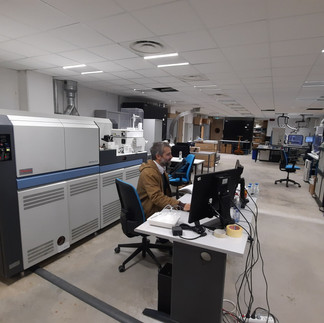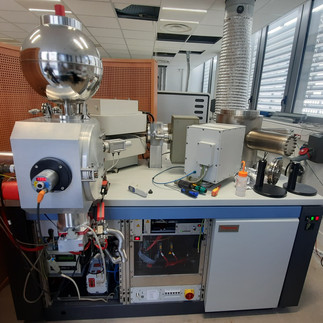Stable isotope analyses at LGL-TPE, ENSL.
- Marius Robu
- Oct 31, 2022
- 2 min read
Part II. The Neptune, other machines and people
Photo 1. Starting to work on the laser ablation system Excimer
Photo 2. First attempt to use The Neptune
Photo 3. An older but more stable mass spectrometer
Photo 4. Thermal Ionization mass spectrometer (TIMS, Triton Plus)
Photo 5. The future. The next generation mass spectrometer. In testing
The Laboratoire de Géologie de Lyon: Terre, Planètes et Environnement (LGL-TPE) of the École Normale Supérieure de Lyon (ENSL) is a large laboratory with a multi-disciplinary background, regrouping researchers with varied interests from earth surface processes to geophysical processes. Dr. Jeremy E. Martin, our collaborator, is part of a team of researchers involved in developing and using analytical tools such as mass spectrometers. His interactions encompass both fields of geochemistry and palaeontology with research interests in paleoecological and paleoenvironmental reconstructions.
Taken together, the ENSL and LGL-TPE represent an absolutely unique scientific environment to develop interdisciplinary studies and collaborations.
The infrastructure provided by LGL-TPE (UMR CNRS 5276) consists, among other fancy tools, of mass spectrometry facilities: 3 multi-collector ICP-MS (Nu 500 HR, Neptune Plus and Nu 1700), 2 quadripole ICP-MS (Thermo X7 CCT and Agilent 7500cx), 1 ICP-AES (iCAP 6000), 1 Thermal Ionization mass spectrometer (TIMS, Triton Plus) and a laser ablation system Excimer at 157 nm; a clean-lab suite equipped with fume hoods and ultrapure acid preparation.
After one month of sustained effort, we were able to perform the calcium (Ca) chemistry for 88 bone samples: cave bears and associated fauna from the Romanian Carpathians. During the next step, we will run our samples on The Neptune, in the coming months. We’ll have, therefore, a solid and precious dataset for our investigations within the INTEGRATE’s project. Moreover, for the next year, we are invited to explore the Magnesium variations (Mg) for our samples, which is another paleodietary proxy.
In parallel, we started working on the laser ablation system Excimer, analysing the trace elements from various tissues of the Carpathian bears. The results are just extraordinary and they will be the subject of a collaborative paper.
Moreover, we discussed future plans and made new collaborations and friends. We had a fruitful working month at LGL-TPE and we look forward to having here new learning/working sessions.
Thank you, France!
.png)













Comments